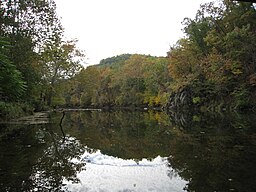Cacapon River
| Cacapon River | |
| River | |
|
The Cacapon River looking south from the Cacapon River Rt 127 Bridge Public Access Site
|
|
| Country | United States |
|---|---|
| State | West Virginia |
| Counties | Hampshire, Hardy, Morgan |
| Source | Lost River |
| - location | Wardensville, Hardy County |
| - coordinates | 39°04′52″N 78°38′10″W / 39.08111°N 78.63611°W |
| Mouth | Potomac River |
| - location | Great Cacapon, Morgan County |
| - coordinates | 39°37′13″N 78°16′58″W / 39.62028°N 78.28278°WCoordinates: 39°37′13″N 78°16′58″W / 39.62028°N 78.28278°W |
| Length | 81.0 mi (130 km) |
| Basin | 680 sq mi (1,761 km2) |
| Discharge | for Great Cacapon |
| - average | 592 cu ft/s (17 m3/s) |
| - max | 87,600 cu ft/s (2,481 m3/s) (March 18, 1936) |
| - min | 26 cu ft/s (1 m3/s) (September 12, 1966) |
The Cacapon River (local /kəˈkeɪpən/ kə-KAY-pən; meaning Medicine Waters), located in the Appalachian Mountains of West Virginia's Eastern Panhandle region, is an 81.0-mile-long (130.4 km) river known for its fishing, boating, wildlife, and scenery. As part of the Potomac River watershed, it is an American Heritage River.
The Cacapon River Watershed is made up of three major river segments and many smaller stream watersheds. The headwaters of the Cacapon River, known as the Lost River, is 31.1 miles (50.1 km) long and receives water from a watershed covering 178 square miles (460 km2). The largest tributary of the Cacapon is the North River, which drains 206 square miles (530 km2), an area comparable to that of the Lost River. Overall, the Cacapon River watershed includes the Lost and North River watersheds, and those of many smaller streams for a total of 680 square miles (1,800 km2). The Cacapon watershed is itself part of the Chesapeake Bay watershed.
In recent years the Cacapon River and its watershed have become threatened by development, and industrial and agricultural growth. Concern about these issues led to the establishment of the Cacapon Institute in 1985 (originally known as the Pine Cabin Run Ecological Laboratory).
...
Wikipedia


